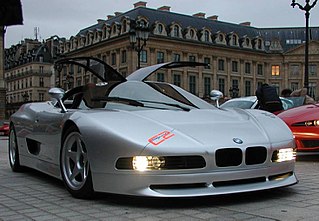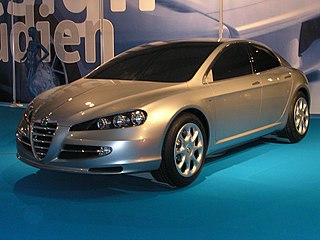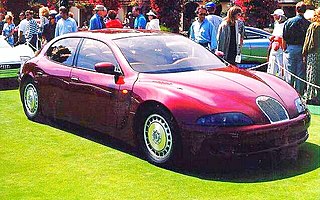Related Research Articles

The Ford Sierra is a mid-size car or large family car manufactured and marketed by Ford Europe from 1982–1993, designed by Uwe Bahnsen, Robert Lutz and Patrick le Quément — and noted for its aerodynamic styling producing a drag coefficient of 0.34, a significant improvement over its predecessors.

The Renault 25 is an executive car produced by the French automaker Renault from 1983 to 1992.

The Bugatti EB 118 is the first concept car developed by Bugatti Automobiles S.A.S. The 2-door coupé was presented at the 1998 Paris Motor Show. Bugatti commissioned the design of the EB 118 from Giorgetto Giugiaro of Italdesign. The EB 118 is powered by a W18 engine and has permanent four wheel drive.

The Bugatti EB 218 saloon is the second concept car presented by Bugatti under the ownership of the Volkswagen Auto Group. The EB 218 was designed by Giorgetto Giugiaro, who also designed the EB 112, the car's predecessor and the EB 118, the car's 2-door variant. The EB 218 can be considered as an update of the EB 112, a concept saloon introduced by Bugatti Automobili SpA in 1993. The EB 218 features Volkswagen's unconventional W18 engine and permanent four-wheel drive borrowed from the Lamborghini Diablo VT.

The Hyundai Pony, is a small automobile produced by the South Korean manufacturer Hyundai from 1975 until 1990. The Pony was South Korea's first mass-produced and exported car. It has a front-engine, rear-wheel-drive layout and variants were made with two-door coupé utility, three-door liftback, four-door saloon car, and five-door liftback or estate car body styles. The Pony nameplate remained in use until 2000 on some export versions of the Hyundai Excel and Accent.

The Alfa Romeo Brera and the Alfa Romeo Spider are mid-size sports cars using the GM/Fiat Premium platform, manufactured by Pininfarina and marketed by Alfa Romeo as a 2+2 coupé and roadster respectively.

The Maserati Biturbo is a family of executive grand tourers produced by Italian automobile manufacturer Maserati between 1981 and 1994. The original Biturbo was a two-door, four-seater notchback coupé featuring, as the name implies, a two-litre V6 engine with two turbochargers and a luxurious interior.

The Lamborghini Calà was a concept car designed for Lamborghini by Italdesign Giugiaro. It was first shown at the 1995 Geneva Motor Show. It was a completely functional prototype that never made it into production. Its name was derived from the Piedmontese dialect of Northern Italy and meant “look, over there!”

The Alfa Romeo Scighera is a functional, futuristically styled concept car designed by Fabrizio Giugiaro and manufactured by Italdesign of Turin, Italy in 1997 for automobile manufacturer Alfa Romeo. The name "Scighera" means mist in the Milanese dialect.
Ford Mustang variants are the various versions of the Ford Mustang car, modified either by its manufacturer Ford Motor Company or by third-party companies. Ford and several third-party companies have offered many modified versions of the highly popular Mustang since its creation in 1964 in order to cater to specific portions of the marketplace outside of the mainstream. High-performance enthusiasts seek more powerful, sharper handling, sports cars such as the Shelby Mustang, the Ford Mustang Mach 1, and variants made by Roush Performance and Saleen, while collectors and purists seek limited production and alternate or nostalgic styling, such as is commonly found on many commemorative editions. Still, others were made purely for experimental concepts such as the McLaren M81 and the Ford Mustang SVO, which later influenced production model design. Most variants include both performance upgrades, and unique cosmetic treatments that are typically minimal to maintain the familiar appearance of a stock Mustang. Although most of these Mustang variants were aimed at enthusiasts, an exception was the Special Service Package which was designed specifically for law enforcement. Race variants include the FR500, Boss 302 and Boss 429.

The Volkswagen Golf Mk1 is the first generation of a small family car manufactured and marketed by Volkswagen. It was noteworthy for signalling Volkswagen's shift of its major car lines from rear-wheel drive and rear-mounted air-cooled engines to front-wheel drive with front-mounted, water-cooled engines that were often transversely-mounted.

The Giugiaro Mustang is a concept car based on the production fifth generation Ford Mustang that debuted at the 2006 Los Angeles International Auto Show. It was designed by Italdesign Giugiaro under Fabrizio Giugiaro, Giorgetto Giugiaro's son. The 2015 Ford Mustang takes many design cues from the concept car.

The BMW Nazca C2 is a concept sports car introduced at the 1991 Tokyo Motor Show. The car was designed by famed automotive design studio Italdesign, home of Giorgetto Giugiaro, and features a similar frontal design of a BMW. It was an evolution of the BMW Nazca M12 from 1991.

The Bugatti 18/3 Chiron is a 1999 concept car developed by French automobile manufacturer Bugatti Automobiles and designed by Fabrizio Giugiaro of Italdesign. Powered by a 6.3 L W18 engine, it is a 2-seater mid-engine coupé. The 18/3 Chiron was the last in a trio of Bugatti concept cars by Italdesign, after the 1998 EB 118 coupé and the 1999 EB 218 saloon.

The Alfa Romeo Visconti is a concept car made by the Italian car manufacturer Alfa Romeo, designed by Giorgetto Giugiaro. The car was seen for the first time at the Geneva Motor Show in 2004. The car is a four-door fastback coupé/sedan and is almost 5 metres (200 in) long. Under the bonnet is a 3.2-litre V6 JTS biturbo engine, which produces 405 PS at 6000 rpm and 680 N⋅m (502 lbf⋅ft) of torque at 2000 rpm.

The Lancia Medusa is an Italian concept vehicle built by Lancia. It was designed by Giorgetto Giugiaro and debuted in 1980 at the Turin Auto Show.
The Porsche Tapiro is a concept car built by Porsche in 1970. It was designed by Giorgetto Giugiaro and has a traditional 1970s wedge design, which critics say somewhat resembles that of the De Tomaso Mangusta. The chassis is based on the Porsche 914/6, and it features gullwing-style doors.

The Bugatti EB 112 is a concept 4-door fastback saloon presented by Bugatti Automobili S.p.A. in 1993. Giorgetto Giugiaro of Italdesign was responsible for designing the car. The EB 112 features a 456 PS V12 engine and permanent four-wheel drive system.

The Giugiaro Brivido is a hybrid sports car concept made by Italian design house Italdesign Giugiaro. It is not slated to go into production. Giugiaro says it is designed to give supercar-like performance while helping protect the earth. It was introduced in 2012 at the Geneva Motor Show.
The Jaguar Kensington is a concept car designed and built by Italdesign for Jaguar. It debuted as a non-running, full-size mock up at the 1990 Geneva Motor Show, and later as a fully functioning prototype at the 1990 British International Motor Show.
References
- 1 2 "1984 Ford Maya: Concept We Forgot". Motor1.com. Retrieved 2018-11-29.
- ↑ "CCotW: Ford Maya (1984-5) - Car Design News". Archived from the original on 2018-11-30. Retrieved 2018-11-29.
- ↑ "TG's guide to concepts: the Ford Maya". Top Gear. 2017-05-22. Retrieved 2019-01-25.
- ↑ "Project: Maya - 1984 - Italdesign". Italdesign. Retrieved 2018-11-29.
- ↑ "Project: Maya II ES - 1985 - Italdesign". Italdesign. Retrieved 2018-11-29.
- ↑ "Project: Maya II EM - 1985 - Italdesign". Italdesign. Retrieved 2018-11-29.